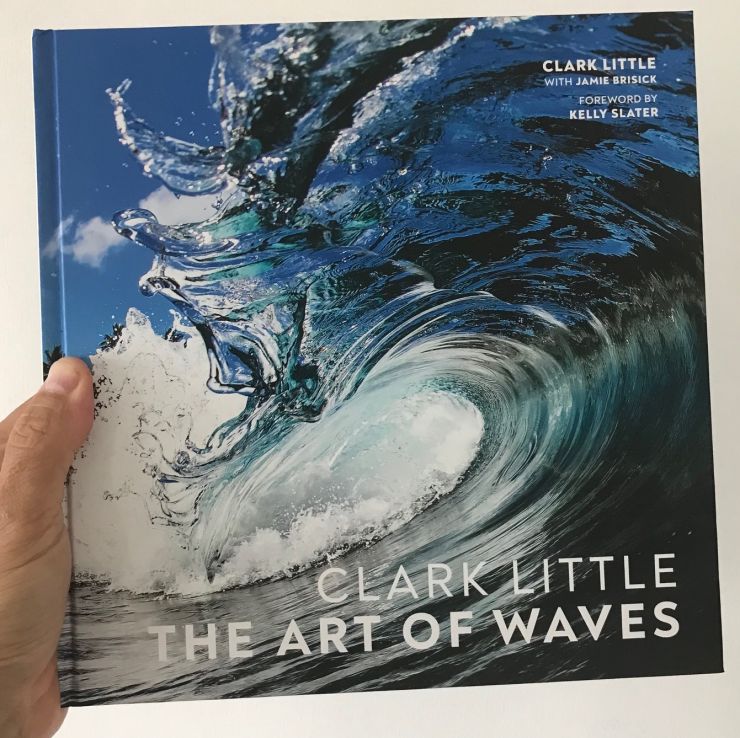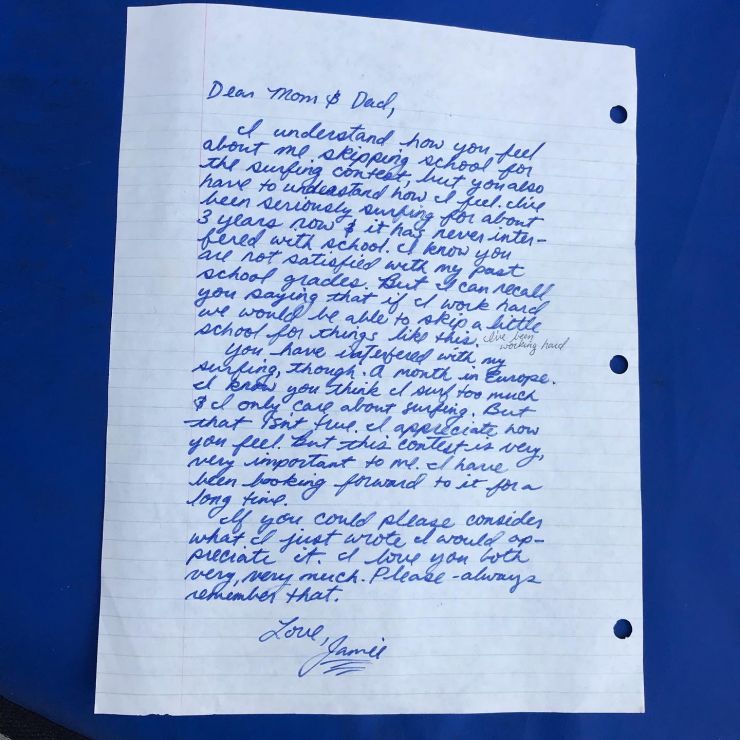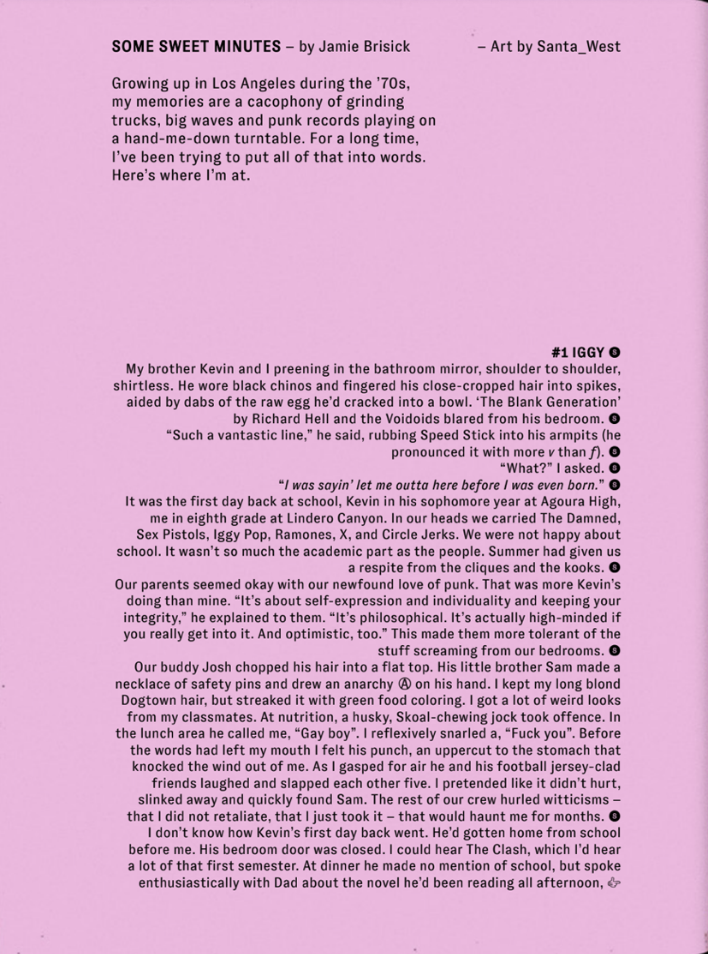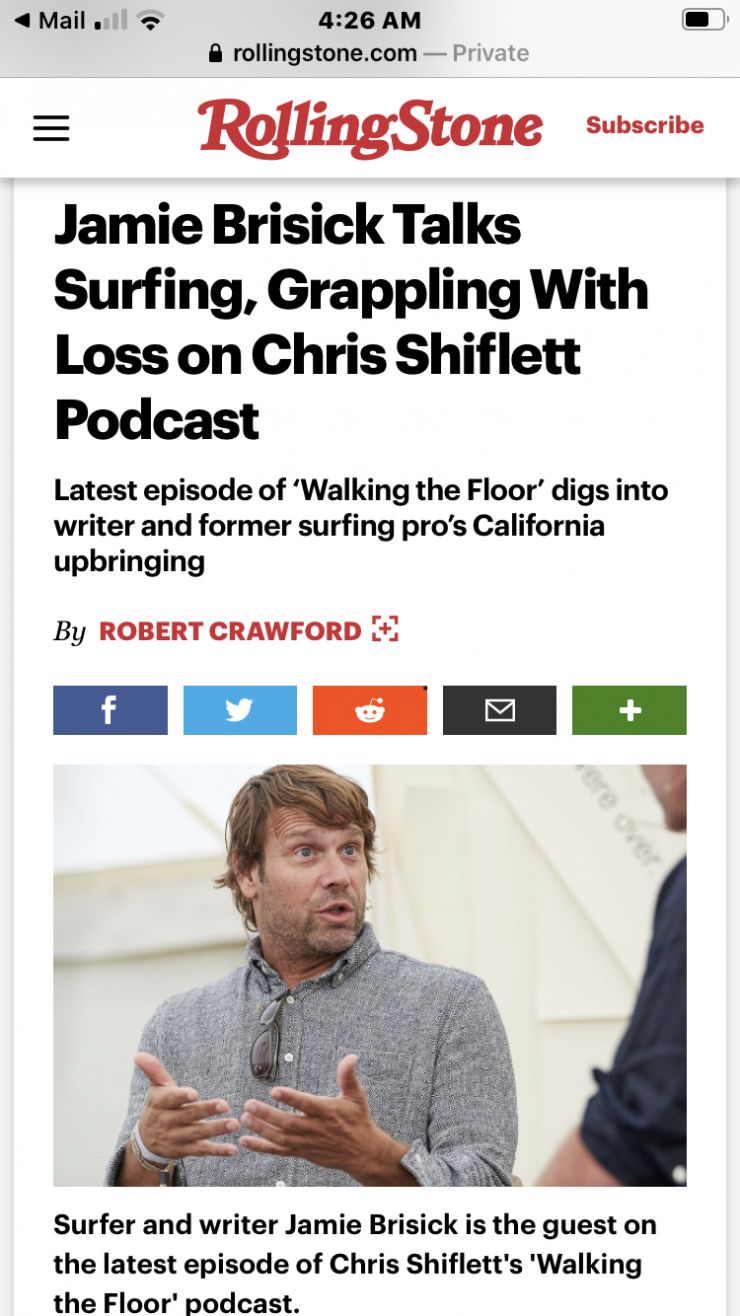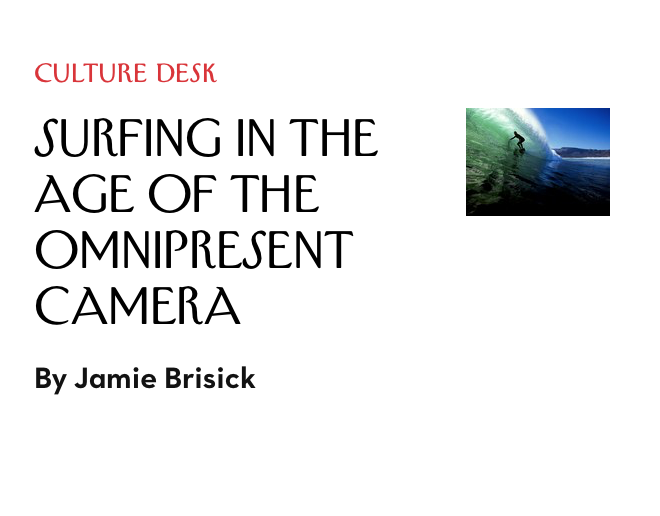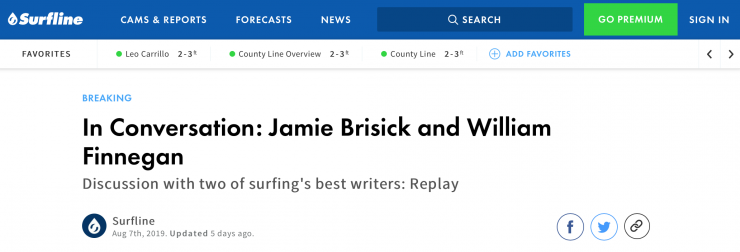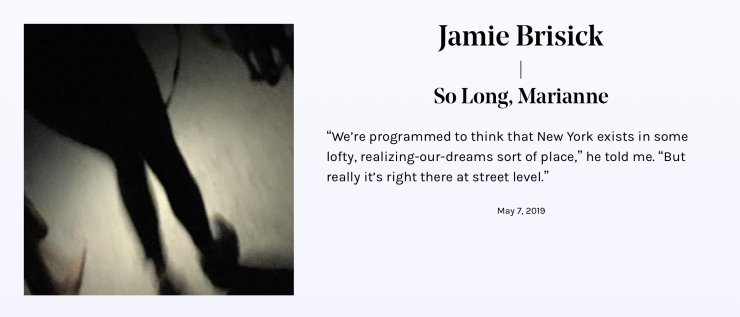https://shepherd.com/best-books/books-about-surfing-that-will-thrust-you-into-the
Books About Surfing That I’ve Read and Very Much Enjoyed
At the Mansplainers Anonymous Meeting (on KelpJournal.com)
At the Mansplainers Anonymous meeting we were given a maximum of twenty-five words to express our feelings
Exceed twenty-five and you were put on coffee duty
By the end of the meeting you’d have a circle of empty folding chairs
And a bunch of men huddled around the coffee pot
Arguing over how to make the perfect pot of coffee.
At the Mansplainers Anonymous meeting we went into extra innings
Overtime
Penalty kicks
They’d begin on a Thursday at 5pm
And still not be finished the following Monday.
At the Mansplainers Anonymous meeting we refused to call it MA
We didn’t believe in acronyms
We had an affinity for the multisyllabic
Though we were working on that.
At the Mansplainers Anonymous meeting we debated intermittent fasting versus time-restricted feeding, Netflix versus Hulu.
At the Mansplainers Anonymous meeting we talked about Van Nuys
Chad said he had a blowout on the 101 over there in Van Nuys
Bruce said, “In Van Nuys, you can just say, ‘I had a blowout on the 101 in Van Nuys,’ you don’t need the ‘over there,’ the ‘over there’ is kind of hurtful to Van Nuys, don’t you think?”
Chad argued that there are places where things happen ‘in’ and there are places where things happen ‘over there in,’ and Van Nuys was an ‘over there in,’ especially considering he was driving a ‘67 El Camino, and that while they were fixing his tire he went around the corner to a topless bar called the Candy Cat where he met a girl named Licorice who he exchanged numbers with and was hoping to see on the weekend
“So in the context of the larger story, if you’d have just let me finish, you’d see that ‘over there in Van Nuys’ is much better than just ‘in Van Nuys’”
“What’d we say about ‘let me finish’?” said Bruce
“Oh shit,” said Chad
The room laughed. There were many things you were not allowed to say at a Mansplainers Anonymous meeting. One of them was “let me finish.”
At the Mansplainers Anonymous meeting we were encouraged to sit in on other twelve-step meetings
So on a Wednesday evening at 6pm I found myself tucked into the Calabasas High School gymnasium with my brethren over there at Name Droppers Anonymous
They were a lot like us, and nothing like us
A redheaded Gen Zer shared how she’d dated ___________, and while dating him she’d met ______________, who introduced her to ______________, and now she’s having a show at his art gallery. Her show features photographs of famous people dining around LA, but inspired by the program, she doesn’t feature the actual famous people, but rather the aftermath of their meals. For example, she said, the caption might read “__________ and _________, Giorgio Baldi, October 9, 2015,” but the photo just shows a couple of pomodoro-smeared plates and the four empty martini glasses from _________, who we now know via testimony from ______________ was a heavy drinker, despite his handsome looks and excellent performances, most recently alongside _________________ in Once Upon a Time…in Hollywood.
At the Mansplainers Anonymous meeting, Twelve Steps and Twelve Traditions, votive candles, a key chain, a dog-eared copy of Men Explain Things to Me by Rebecca Solnit.
At the Mansplainers Anonymous meeting
Actually, after the Mansplainers Anonymous meeting
I brought the fellas out to my car
The engine pinged when driving up steep hills, and it had been burning through oil like there was no tomorrow
This was at the North Hollywood meeting
Filled to the gills (as the expression goes) with washed-up actors and stuck screenwriters
Parked in the adjacent Gelson’s lot, hood up, there was at first about fifteen of us
But then something beautiful happened
More men started showing up, dozens weighing in on what might be the culprit
Bad spark plugs, worn out piston rings, maybe the transmission
It was like a tailgate party, but with everyone gathered around the hood.
And while a tailgate party involves many cars, this was just one, my 2003 Mercedes G-wagon, and what by the end of the night must have been a good hundred-and-fifty of us.
In The Malibu Parking Lot (in Heavy Traffic III)
In the Malibu Parking Lot
by Jamie Brisick
In the Malibu parking lot, there were rules
Rule #1: Don’t drop in
Rule #2: Share your weed
Your wax
If you have a second beer, pass it along
Tomorrow you’ll be thirsty
Rule #3: Acknowledge Malibu Carl. Say hi to Parking Lot Teddy
Rule #4:
(Not so much a rule but an understanding)
There is no problem so big or complicated that it cannot be run away from
At the Malibu Wall, we chased nose rides, blow jobs, beer
At the Malibu Wall, we had no health insurance
At the Malibu Wall, a fin chop could take the whole thing down
As it had for Parking Lot Teddy
Not his own fin but a freshman from Pepperdine’s
Who’d been surfing less than a year
22 stitches
$3700 at St. John’s
Now Teddy sleeps in his van
In the alley behind Ralphs
At the Malibu Wall, there was blood
At the Malibu Wall, it was not Teddy’s
At the Malibu Wall, last we heard the Pepperdine kid had taken up golf
In the Malibu parking lot, I surrendered my virginity to a bronzed lioness of a regular foot named Ashley. Her skin smelled of Coppertone. Her left-go-right bottom turn was fierce. For a summer we lived in her beater van, subsisting on Jack in the Box tacos and Tecates stolen from the back of the liquor store. She called me dude, as in “Slow down, dude,” “Little to the left, dude,” “Try again, dude,” “Okay, D minus for today, now let’s go get a wave, dude.”
In the shimmering waters of Malibu, my mascara ran, my lipstick sprinted, my facelift pole-vaulted, my raw and unvarnished self stood soft and vulnerable across the three-foot peelers. The afternoon sun was a French kiss. The light onshore wind carried the wisdom of the ancients. Neptune three-pronged me the way a cattle rancher brands his cow. Magellan slapped me and said, “Not a 50-foot nose ride but a 360-degree odyssey, an entire life. So less of the rum and more of the captain’s log, if ya know what I’m sayin’.”
At the Malibu Wall, we hid behind dark sunglasses
And spoke with our hands
At the Malibu Wall, we traded sex
For a chocolate shake, large fries, and a double cheeseburger
At the Malibu Wall, it happened in the men’s room
At the Malibu Wall, Parking Lot Teddy guarded the door
In exchange for half the shake
And a couple bites of the cheeseburger
At Malibu Wall, we didn’t use fancy words like ‘transactional’
At the Malibu Wall, we were hungry
And we ate
In the Malibu parking lot, I wrestled with my masculinity, which spoke in a gravely, Scotch-and-Camel-non-filters tone, and at one point grabbed me by the shoulder in a way that my 2021 self found aggressive. I said, ‘Please remove your hand from my shoulder.’ My masculinity removed its hairy hand, cackled, shrugged its macho shoulders, and said, ‘What the hell happened to you?
In the Malibu parking lot, the rear hatch of a ’77 Econoline popped open. Out flew a Nike. Then a wetsuit. Then an MSA jacket. Then another Nike. Then an 8-foot Liddle displacement hull, which landed nose first, making it something like a 7’9” or 7’8” “And stay the fuck away from me you piece of shit,” shouted Ashley. I crawled out the passenger side door, retrieved my things, made my way towards the pier.
At the pearly gates of Malibu, I poured out confessions (hiding six-packs in my backpack, not sharing joints with Malibu Carl, borrowing Grossrider’s prized 9’ Yater without asking). There was a tribunal of sorts involving Bosco and Trace and Parking Lot Teddy. They told me to hold tight, disappeared into Teddy’s van, shut the door, re-emerged 20 minutes later. “Carton of cigarettes for Carl, bottle of tequila for Teddy. I’m on the wagon this week so basically I get to drop in on you every chance I get,” said Trace. I nodded compliantly. He pointed seaward. A sparkling head-high set peeled across First Point. “Carry on,” he said.
In the Malibu parking lot, I managed to locate my inner adolescent. He emerged from the men’s room with bloodshot eyes and beer on his breath. “I miss you,” I said. He looked over his shoulder then back at me. With a confused expression he said, “Do I know you?”
In the Malibu parking lot, I remembered Seaweed, who called it the workajerka.
“Every job I ever had just seemed to grab me by the back of the neck and drop me somewhere inland. I don’t do the workajerka.”
Seaweed lived out of his car, a ‘57 Comet wagon. He did not believe in deodorant (“That’s our body’s irrigation, you can’t block it up.”) He believed wholeheartedly in bongloads (“I like to put ice in there. End of a long hot summer day on the beach, an ice water bong, life doesn’t get any better than that”).
I remembered John, who’d go on to a successful art career. Malibu was part of his narrative, his education, the thing he left behind.
“One day I was pulling out of the lot and I just knew, you know? I drove out real slow, took it all in. I turned south on PCH and never went back.”
I remembered Charlie, a regular foot with a big frontside carve. Charlie was reluctantly sober. In a low ebb, nursing yet another hangover, I said, “Charlie, I think I might need to get sober.”
Charlie rested his hand on my shoulder. “Whatever you do, don’t get sober. The sober you will just be another kind of annoying that no one will want to be around.”
It was Charlie who also said: “You start hanging out in the Malibu parking lot…and you become the Malibu parking lot.”
In the Malibu parking lot, I spilled oil, blood, ink, semen, Mr. Zog’s Sex Wax
In the Malibu parking lot: ghosts
The ghost of Miki, Moondoggie, Tubesteak, Lance, Dewey, The Enforcer, Fruit Loop, Head and Shoulders, Seaweed
In the Malibu parking lot, beer was consumed, facts were muddled, words were slurrred
In the Malibu parking lot, summer’s ready when you are
In the Malibu parking lot, in the summer, in the city
In the Malibu parking lot, and the livin’ is easy
In the Malibu parking lot, boys in bikinis, girls in surfboards
In the Malibu parking lot, everybody’s rockin’
In the Malibu parking lot, an American songbook
In the Malibu parking lot, Woody Guthrie was a regular foot
JayZ a goofy
In the Ma
In the Malibu parking lot, sex in the back of Steve and Ashley’s ‘77 Econoline van, Bizarre Love Triangle by New Order on the stereo, wet wetsuits at our feet, the rail of Steve’s 8’2” Anderson pushing into my hip, the taste of Starbucks and cigarettes on Ashley’s lips
In the Malibu parking lot, we never plan these things
In the Malibu parking lot, Ashley says she loves me
In the Malibu parking lot, Steve comes back from Mexico on Friday
In the Malibu parking lot, I am not quite a red belt, but I’ve got a few tae kwon do moves up my sleeve
In the Malibu parking lot, Steve’s a jiu jitsu black belt
In the Malibu parking lot, I have an uncle up in San Francisco who keeps telling me to visit
In the Malibu parking lot, a west swell coming next week
In the Malibu parking lot, west swells like Ocean Beach
In the Malibu parking lot, a note slid under the windshield wiper of Steve and Ashley’s ‘77 Econoline van
In the Malibu parking lot: I was a hippie I was a burnout I was a dropout I was out of my head
In the Malibu parking lot: Two sides to every story
In the Malibu parking lot: Somebody had to stop me
In the Malibu parking lot: I’m not the same as when I began
In the Malibu parking lot: Punk rock landed with a splash
Clear boards/black wetsuits turned into leopard-spotted boards/pink and purple wetsuits
In the Malibu parking lot: Abracadabra
In the Malibu parking lot: Paris Hilton, Britney Spears, and Malibu Barbie
Puff a joint
Behind the lifeguard tower
Lots of sunscreen, dark sunglasses, wide-brimmed hats
In the Malibu parking lot: Development was arrested, growth was stu
In the Malibu parking lot: In the maw of Peter Pan
At the pearly gates of Malibu, I felt the black dog, the mean reds, the Nausea, the dark night of the soul at 3am, though it was 4pm, and sunny, and 81 degrees.
At the pearly gates of Malibu, I called upon the holy texts of Pema, I clenched my fist the way Tony Robbins would, I promised myself I’d study The Work of Byron Katie.
At the pearly gates of Malibu, Timmy was kind enough to lend me his 11’ glider, decorated in polka dots, and I paddled out on it, imagining that they were not polka dots but pills (Xanax, Zoloft, Wellbutrin) and that the waves were not oceanic waves but the blue waves of the Democratic party, scooping me up and gli
In the Malibu parking lot, I saw a Debbie Harry-looking woman wearing a Malibu sweatshirt. I said, “Where’d you get it?” She said, “Rule number one: Never ask ‘where’d you get it.’” I said, “Fuck off. Tell me where you got it.” She blew a bubble. As it popped on her Chapstick-glossed lips I was hit with a waft of grape Bubblicious. Nostalgia floored me. Coppertone. Wine coolers. A keg party in Woodland Hills. A Dead Kennedys show at the Whiskey. I said, “Didn’t we have sex in the backseat of a Volkswagen Rabbit behind the Jack in the Box in Agoura in, like, 1982?” She said, “Brothers Marshall.” I said, “You had sex with Brothers Marshall in the backseat of a Volkswagen Rabbit behind the Jack in the Box in Agoura?” She said, “No, idiot. I got the sweatshirt at their new shop, down there by Duke’s, next to the breakfast burrito joint, near the hardware store, a couple doors down from Malibu Divers, which, by the way, is also the title of a really atrocious porn film, made right around 1982. Maybe you know it?”
In the Malibu parking lot, tequila, vodka, Tecate, Diet Coke. In the Malibu parking lot, tomfoolery, Tom Curren, Thomas Campbell, Tomás the Argentinian parking lot attendant. In the Malibu parking lot, Marilyn and JFK, Gidget and Moondoggie. In the Malibu parking lot, graffitied on the wall: “Without art we are but monkeys with smart phones.” In the Malibu parking lot, an 8’6” Yater swapped for a 6’10” Skip Frye. In the Malibu parking lot, sea gulls attack a Jack in the Box bag. In the Malibu parking lot, high tide, high noon, high times, hi Mom. In the Ma
At the Church of the Open Sky that is Kiddie Bowl, I did not say three Our Fathers and six Hail Marys but rather banged seven lips and pulled into nineteen tubes
In the Cathedral of Forever Facing Seaward that is First Point, Nate dropped in on Randall, Randall called him a shoulder shark, and the N-word, and punched him in the face
They took it to the beach
Hurl a whole watermelon at the ground and that’s what it sounded like, Nate’s fists banging into Randall’s wet torso and face and head
Randall slithered free, punched the fin out of his board, held it up like a knife
Nate was fighting for much more than the wave
Or the bully that was Randall
Pinning Randall and his fin-wielding hand to the ground, Nate punched and punched
The next day Randall showed up with a gun
Guns don’t hide so well in boardshorts
In the Malibu parking lot, a row of cop cars
Randall in handcuffs
Silent applause from all of us who’d had run-ins with Randall
Randall disappeared for a few days
Nate, sadly, never came back
In the Wild West that was Malibu that summer
Frontier justice prevailed
But not really
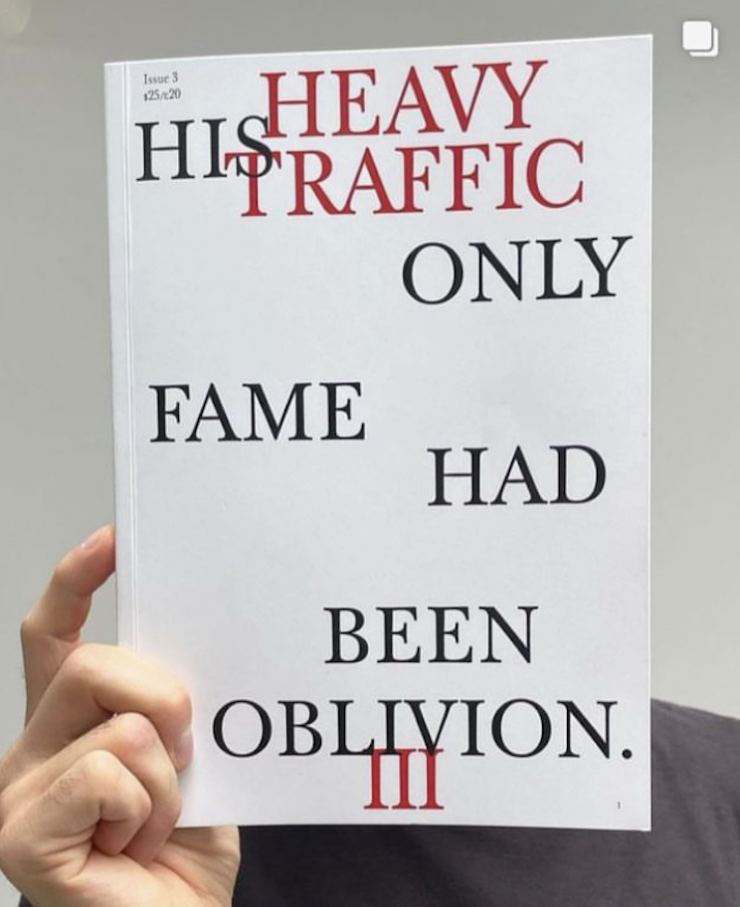
“Ashley Bickteron, Unflinchingly Honest About His Work and Illness” in NY Times
AN APPRAISAL
Ashley Bickerton, Unflinchingly Honest About His Work and Illness
Last words (and works) of the artist diagnosed with ALS in 2021. A devoted surfer, he chose to live remotely in Bali, away from the buzz. It found him anyway.
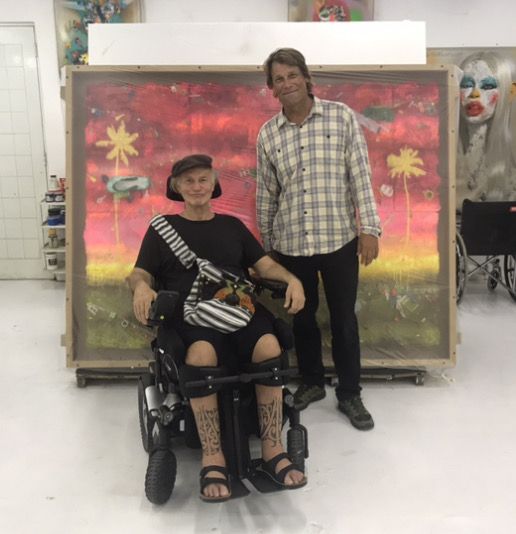
“I can’t think of another artist who was both brilliant on canvas and on a surfboard,” said Paul Theroux, the writer. He was speaking of one of the artists he most admired, Ashley Bickerton, and these words of Theroux’s inspired me to plan a trip to his home: “If Gauguin had caught some waves in Tahiti then I think we’d have an apt comparison.”
Ashley rose to prominence in the mid-1980s with ironic, abstracted constructions focused on ideas of consumerism, identity and value. He had been diagnosed with ALS in 2021, and by July, when I finally visited him in Bali, he needed help bringing food to his mouth, and he could no longer paint. But there was not an ounce of self-pity. “I consider myself enormously lucky,” said the artist from his power wheelchair. “It’s an incredible luxury that I can sit here on my big veranda on the hill overlooking the Indian Ocean, spend time with my wife and daughter, work on my computer, think, dream and put my life in order.”
He was courageous, graceful, eloquent, inspired. And full of gallows humor. After a Thai feast at his sprawling compound on the southern tip of Bali, I gestured toward his wife and three-year-old daughter, who were playing on the sofa, his paintings and sculptures surrounding us, his swimming pool and spectacular ocean view, and said, “What a beautiful life you’ve made for yourself.” With a rosy-cheeked grin he said, “What’s left of it.”
Ashley died on Nov. 30. He was 63.
“The Dazzling Blackness” for Huck Mag
Clark Little: The Art of Waves
Raymond Pettibon’s “Point Break”

“When Life Revolved Around the Waves” - the North Shore in WSJ
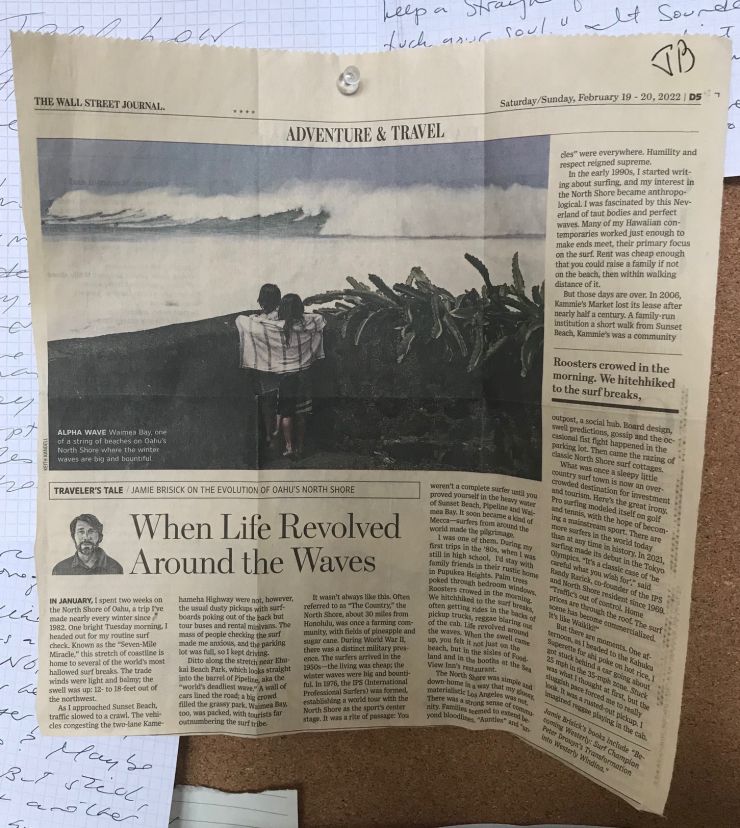
Nearly Fossilized in the Dirt
We passed a pair of underwear, sun-bleached and nearly fossilized in the dirt. Further along was a bra, and then a shattered Jack Daniels bottle, and then the faded remains of a Trojan wrapper.
“Someone got laid,” said Kevin.
He said it with conviction, as if he was in on something that I wasn’t.
We climbed a crumbly hill that led out to a summit overlooking the whole of Westlake. You could see the cul de sacs, the man-made lake, the greenbelts, the tennis courts, the swimming pools, the stuff that we would soon come to know as “suburban mediocrity.”
“Looks like a bad idea,” said Kevin.
He unzipped his shorts and took a piss. I did the same.

Love Letter, Love Letter
The Beautiful Flower Will Wilt, The Beautiful Flower Will Die
1985. Ronald Reagan. “We Are the World.” AIDS. “Like a Virgin.” An exploding surf industry. A powder keg of a world champion: Tom Carroll, uber-athlete, hard charger—at giant Pipeline and at the nightclub at 1:44 a.m. I had feelings that scared me for a girl named Julie. And something dirty with Carolyn. Mostly I had a 6’2” Al Merrick thruster and three WSA West Coast Championship titles.
I turned pro that summer. To kick off my giant leap, Quiksilver, my sponsor, sent me on a photo trip to Natividad. Photo trips were a new thing. There’d always been surf trips (Endless Summer, Naughton-Peterson), but photo trips were more about getting ad shots for the brands than editorial for the mags. Also new was the “photo guy” (or “photo whore,” depending on who you were talking to). Today we call them “freesurfers” without blinking an eye. But back then the notion that you could earn a living simply by getting your mug in the mag was unprecedented.
Leading this charge was my friend and mentor, Willy Morris. His 6’2”, 220-pound frame did him no favors in the ASP events, held way too often in small waves, but he could chuck giant spray that looked great in photographs.
It was Willy who put together our trip. He and Surfing magazine photo editor Larry “Flame” Moore had been monitoring the chubasco swell; the buoys were 4 to 6 feet at 20 seconds—perfect for Natividad. Willy picked me up in front of my house at 4:30 a.m. In his new, gunmetal-gray Jetta, bought with the money he’d been making through photo incentives, we headed south to the border and followed the much-potholed 1D coastal road to Ensenada Airport. There we met up with the rest of the crew: Richard Cram, Bryce Ellis, Sam and Matt George, JP Patterson, and Flame.
The morning sun blazed. The wind whipped precariously, especially given the flimsy look of the propeller plane that would fly us the 450 kilometers south to Isla Natividad, a tiny island home to Open Doors, a beachbreak that served up whomping A-frames. It was hailed as a sort of photo studio: Prevailing winds blew offshore, and it was brilliantly front-lit by the afternoon sun.
The seating arrangement on the plane was more bus than aircraft. A handful of leathery fishermen occupied the first couple rows. They laughed a lot, mostly at us gringos. An elderly woman sat behind them. She wore what looked like a nun’s tunic, and on her lap she held a live chicken. Behind her was a wiry old man holding a leash attached to a scruffy gray goat. Our surfboards occupied the center aisle—a major fire hazard, but there was no one to regulate that stuff.
I did not know my fellow photo-trippers when we boarded the flight, but by the time we hit the ground at Natividad I felt like I did. Flame was meticulous, hyper-organized, possibly a germophobe. He also guarded his camera gear as if someone might steal it. Clad in Reeboks and sweatpants, Bryce and Crammy were serious athletes. They hid behind Walkmans, did the occasional forward bend, and seemed slightly put off by the Tres Mundo of it all. JP Patterson was bodyboarding’s first legit pro, and spoke of Waimea barrels. Sam and Matt exuded the “When in Rome…” spirit. They did not speak Spanish, but nonetheless joked with the fishermen, charmed the old lady, petted the chicken, scratched the chin of the goat, and poked their Heckle-and-Jeckle heads into the cockpit to chat up the pilot.
Approaching Natividad’s dirt landing strip, heads pressed to the windows, we saw what from above looked like excellent waves. They were exactly the pounding peaks I’d seen in recent issues of Surfing. The wind blew a strong offshore—or was that the wind kicked up from our plane? We flew so low over the surf that it was hard to tell. Our landing was immaculately smooth. The goat did not bleat. The chicken clucked only a little. We exited and dragged our gear up the landing strip and across a scrubby field to a group of cinder-block bungalows that reminded me of Fred and Wilma’s house in The Flintstones.
Natividad was occupied by a couple dozen families, most all of them fishermen. There were no hotels. You rented bungalows, which were really just family houses. We checked in with the family Flame had stayed with on his last trip, and walked across the center square to our accommodations. I bunked with Willy and Flame, the Aussies took the bungalow across from us, and Sam and Matt took one around the back. Our room had three cots, a couple of plastic chairs, a TV, and lots of Virgin of Guadalupe artifacts on the walls. We did not bother to unpack. We grabbed our boards and wetsuits and bolted for the surf.
The waves were throaty, the water surprisingly chilly. Flame set up his tripod down the beach from us and shot into the rights. I got a few, though my timing felt off and I was nervous about the camera. The others surfed brilliantly. Willy in particular rode with masterful command, picking all the right waves and hitting all the right spots.
We surfed until the sun disappeared behind the horizon and the sky turned to tequila sunrise, or more like tequila sunset. On the walk back we passed a gaggle of barefoot kids playing soccer on the landing strip, their shoes set up as goal posts. They laughed at us, just as the fishermen on the plane had. Matt George dropped his board and joined them for a few kicks.
At our bungalows we showered under a trickle of cold water that dripped from 6 inches of hose poking out of a cement wall. Then we dressed and headed over to the main house for dinner, which Flame explained worked like a B&B, albeit with all three meals. Our hosts—Familia Gutierrez, I’d learn—served up rice, beans, a baked white fish, and a lobster soup. We drank one beer each. We talked about Hawaii. Sam and Matt described a recent luau they’d attended. “Hawaiians don’t eat till they’re full, they eat till they’re tired,” said Sam. Flame told a terrible story about a guy who’d face-planted into the shallow sandbar at Open Doors and broken his neck. There were no medical facilities on Natividad, and, by the time they had airlifted him out of there, he’d downed a full bottle of tequila to kill the pain.
We finished our meals, thanked the Gutierrezes, and ambled back to our rooms. Willy and Flame talked about boats—the Radon Sport 21, Hobie Cats. Sam and Matt spoke passionately about a recent marathon they’d run, and, as we passed my bungalow, I understood it that I should follow them, and we said good night to the others.
“Set your alarms for six o’clock,” were Flame’s final words.
In their room, furnished much like ours, Sam laid on the concrete floor with his legs pressed vertically up the wall. “Good for circulation,” he said. Matt raved about a girl he’d met on a recent trip to Tahiti.
“It was like we’d known each other for 11 lifetimes, and Jame, we fell in love. It was the real stuff. I’d hurl myself in front of a train for this girl.”
“Where is she now?” I asked.
“In her little cottage up in the trees above Taapuna, probably cooking dinner for her father or shampooing her little brother’s hair. She had these breasts that looked like they carried milk for the entire world. She was a flower. A beautiful flower.”
“Why didn’t you bring her home with you?”
“Ah, no! No, Jame. It’s not like that. No. I’ve traveled enough to understand these things,” he said, and brought his hand to his heart as if pledging allegiance. “You can admire the beautiful flower. You can smell the beautiful flower.” He shut his eyes and inhaled sensually. “You can even touch the beautiful flower.” He swirled his fingers in a little circle. “But you cannot pick the beautiful flower and bring it back to smoggy, stressed-out Southern California, because it will wilt and it will die. Sam, back me up on this one. Am I right?”
Sam still had his legs up the wall: “You’re not always right, Matt, but you’re never wrong.”
Matt moved over to the TV and flipped through the stack of videotapes atop it.
“Oh, yeah! Sam, Jame, we have Deep Throat.”
He held up the sleeve and read aloud: “How far does a girl have to go to untangle her tingle? Eastmancolor. Adults only.”
Matt inserted the tape into the VCR, and in that little room alongside the landing strip on Isla Natividad, population about 75, we watched Deep Throat from start to finish. And for those 61 minutes, Sam and Matt George, the most talkative men I’d ever met in my life, did not speak a single word.
I couldn’t sleep that night. Too much stimulus: Linda Lovelace. Too many vivid impressions: Crammy’s backside cutback. Too much snoring: Flame. Tossing and turning—mattress coils like teeth, pillow like a stone slate—I thought about girls.
A few nights before I left for Natividad, I was headed out the door to go to a party when my father, seated alone at the dinner table, stopped me.
“You know,” he said, “when you’re with a girl, Jamie, it’s just you. It’s not Jamie the pro surfer or Jamie the guy in the surf magazine. It’s just Jamie. It’s just you standing naked, no masks, no labels. Know what I mean?”
I thought about Julie and wondered if my inability to talk to her was some kind of survival mechanism. If we’d have fallen in love, then what? Instead of falling in love with Julie, I slid into something emotionless with Carolyn, a model and occasional purse-snatcher. (I’d witnessed the latter firsthand.) I met her on a Quiksilver shoot. She was on parole for her second DUI. She was 17. Carolyn had thick brown hair and porcelain skin and pouty lips that more often than not were clamped around a Marlboro Red. Her giraffe-ishly long legs poked out of ridiculously high skirts. She called her girlfriends “hooker,” and eventually started calling me “hooker.”
Carolyn lived in a one-bedroom apartment in Encino that her absentee father paid for. She liked to have sex on the shag carpet, where we’d worm our way closer and closer to the fireplace, so that burning-hot faces and climax were synchronized. I spent about a half-dozen nights with her. And on every one of them—usually late, close to midnight—there came a knock on the door. Carolyn would raise a finger to her lips. The knocks would advance to pounds. The doorbell would go haywire. Then it would stop for an hour or two. Then it would start again. I noticed a difference in the cadence and force of the first and second round of knocks, and wondered if there was more than one man trying to get at her.
The next two days on Natividad were terrific. The swell came up a touch; the wind continued to blow offshore. The A-frame-shaped waves sometimes connected with a second A-frame, so that we’d drop down the face in a low tuck with rear arm jammed into the water to create drag to slow you down and maximize tube time, then exit the tube, pump, pump, pump, and backdoor the next A-frame, which was like an abbreviated, watery version of that tunnel we drove through on Malibu Canyon.
Willy carved huge, winged top turns. Crammy and Bryce sliced and diced. Sam and Matt seemed to take more pleasure in the recounting of the rides than the rides themselves. At dinner they were like a pair of seasoned sports announcers doing their post-game parsing. Flame spent most of the hot and bright hours standing behind his 600mm lens, though he did swim out and shoot from the water a couple of times. Open Doors broke hard in shallow water. He less swam than stood in the waist-deep impact zone and hollered us into waves. It didn’t matter if they were makeable or not. It was closer to modeling than proper surfing. We’d stroke, pop to feet, pose in barrel, then get crushed. In one rag-dolling wipeout, I felt Flame’s fins, head, and housing. It was strangely intimate. When we surfaced four seconds later, I felt like I knew him better.
These were pre-digital days, of course, so there were no photos to look at after, only Flame’s recollections. “That thing was a frothy pit,” he said of one of Willy’s waves over lunch. Hoping to get a laugh, I turned to Sam and Matt and said, “Natividad is full of frothy pits.” Matt rested a paternal hand on my shoulder and said, “Ah, Jame, that’s just the porn talking.” And for the rest of the trip that became our inside joke. And to this day, 35 years later, I’ll run into Sam and Matt and they’ll wait for the right moment and give a slight shake of the head and say, “That’s just the porn talking.”
The last day of the trip was September 17, my 19th birthday. I told Willy that morning. He told the rest of the crew. At breakfast I was casually wished a happy birthday. By dinnertime we were all celebratory. Sam wore a sombrero he’d bought in Ensenada. Matt wore a Lawrence of Arabia scarf. We ate grilled snapper with a citrus sauce and rice and beans. There was more beer than the previous nights. And as Mamacita cleared the plates from the table, Willy produced a bottle of tequila. He poured out shots. We toasted. Mamacita and Papacito appeared from the kitchen with a chocolate birthday cake topped with 19 lit candles. All sang “Happy Birthday,” the Spanish and English running over the top of each other. I closed my eyes, made a wish, and blew. The cake tasted dusty, in the same way that all of Natividad did. It was good and not too sweet, the frosting thick and gooey.
The fun didn’t stop there. With the tequila bottle in hand, Matt led us outside and around the back of the bungalows to a small courtyard where nearly every resident of Isla Natividad had gathered. They were waiting for us. The gringo’s birthday was cause for celebration. Cans of beer topped the sole picnic table. An elderly man in a cowboy hat played a guitar and blew into a harmonica. Kids lit firecrackers and threw them into the night. Hanging from a tree was a piñata, or a pillowcase doubling for one. After the first bottle of tequila was finished, a second one came out. There were no glasses. We swigged from the bottle and passed it along.
Once we were good and wobbly, Matt came over, kissed me on the cheek, unfurled his scarf, and wrapped it around my eyes. A blindfold. I heard Spanish-speaking voices moving closer. Someone handed me a baseball bat. I heard kids’ laughter. I smelled cigarettes. Little hands grabbed my hands and led me around in one circle, two circles, three circles, four. The laughter rose. I stumbled, nearly fell over. “Àndale!” they yelled. I stepped forward in what I thought was the direction of the piñata and swung. I hit nothing. Laughter. I stepped to the left and tried again. Nothing. I swung furiously and widely, hoots, hollers, “Àndale!”s. Then I connected. I heard the sound of the piñata’s guts spilling on the ground. I peeled off the scarf. On hands and knees the village kids picked through the contents. It was not candy, but surf stuff—leashes, bars of wax, at least a half-dozen Astrodeck tail patches, a few Nose Guards, and a bunch of stickers.
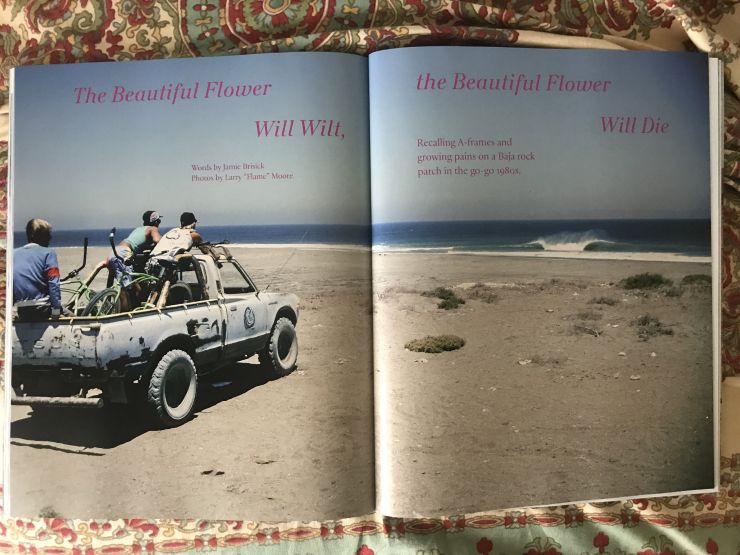
Some Sweet Minutes
Derek Hynd from a 2013 issue of Victory
DEREK HYND AND THE F-F-F-F-FOUNTAIN OF YOUTH
By Jamie Brisick
About three years ago a video was posted on YouTube that not only captivated the surf world, but got it scratching its collective chin with what ifs? In it, Derek Hynd takes off on a series of double-, sometimes triple-overhead waves. All appears to be normal at first. He rides in a low crouch, rear hand tickling wave face. But there’s a subtle drift in effect. The usual traction between surfboard and wave is non-existent. As the clip kicks on we see Derek slip and slide and drift and careen and ride backwards and spin a fit of dizzying 360s.
“About fifteen years ago I watched the Daytona 500 live, and wanted that feeling on the high line,” says Derek. “I got to wonder in less than a second what it’d be like to deliberately lose friction going as fast as I could, but increase the speed. That’s what I got a glimpse into when the leading car—green car 66, I think—lost it with the field up its backside, and for a tiny moment put a gap on the chasers until it flipped multiple times. It lost traction thus friction and went faster for a flash. With the pack less than a yard behind at 200mph high on the speed bank, I saw the shift.”
Derek has had a long and colorful ride in surfing. He’s been a pro, a coach, a journalist, a marketing genius, a critic, a test pilot, a historian, an impresario, and now, at age 55, a finless surfer. It’s key to understand just how important fins are to surfboards. They provide the bite, the hold, the traction. They are what keep the board pointing forward. Without fins (or a fin), there is very little to cling to the wave face. Finless, a surfer is not unlike a child sliding down a snow hill on an inner tube.
In some ways it makes perfect sense that Derek would find finless surfing. While his contemporaries have gotten fat and taken on middle-age responsibility, Derek is lithe and carefree and continues to live the surfing dream as if he were still 21. He travels far and wide on the hunt for waves, rarely missing a swell. He has been an outspoken critic of the cookie-cutter surfing that takes place on the ASP (Association of Surfing Professionals) tour—as well as its cookie-cutter equipment. He reads Dostoyevsky and Proust and Nabokov, and will describe a particular wave he rode ten years ago, or even a particular turn he did on that wave, the way Humbert Humbert describes Lolita.
“When the wave is going super fast, and a board that shouldn’t be matching it is matching it,” he says, right hand driving an imaginary board across his face, “it leaves you breathless about the potential of where surfing may have gone 50 years ago had the fin never gained such static popularity. I got a wave this year at Jeffreys, a big wave, and I was on it and the sections were coming toward me and I wasn’t going to make it but I was making it, and I was aware of my mouth getting wider and wider open, and the wind getting in my mouth, and I was conscious of knowing that the board’s out of control, no, it’s in control! whoa, what’s happening to me? what’s happening to the board? It was at a point of maximum velocity. I’d passed through some sort of barrier.”
Pro surfing is a young man’s game, not only because contemporary high-performance wave riding is extremely gymnastic, requiring fast-twitch muscles, but also because the industry is built primarily on apparel, i.e., fashion. Like the fashion world, surf mags and websites are rife with tanned, muscled, wrinkle-less teens and twenty-somethings. This is how the surf dream gets sold. “How does the industry treat pro surfers once their careers are over?” a former world champ once told me, “They hand you a gun, they tell you to go outside, ‘round back, and into the shed. Stick the gun in your mouth like this (he brought a finger to his mouth) and pull the trigger. But do us a favor. Put a silencer on it. We don’t want our stocks taking a dive.” In short, ex-pros often end up marooned and bitter. Those lessons learned from riding waves—to improvise, to duck and weave, to be mercurial—rarely translate into terrestrial mid-life and beyond.
One of the ways pro surfers stay sane in the wake of their competitive careers is by experimenting with boards. Three-time world champion Tom Curren did this in the ‘90s to great effect, inspiring a fascination with vintage and alternative wavecraft that has endured and is presently exploding (see Mollusk in San Francisco and LA, Pilgrim Surf + Supply in Williamsburg). Few people realize that Derek Hynd had a large hand in this. In the early ‘90s Derek began to lose faith in competitive surfing. As the global economy tanked, and Kurt Cobain sang his anthemic “Oh well, whatever, nevermind,” Derek went searching for surfing’s roots. In South Africa he built a pyramid-shaped house overlooking Jeffreys Bay, one of the world’s longest and best waves. He decked the house out with a nearly 90° slide that connected his capsule-like bedroom to the living room, where dozens of boards—some bought at garage sales and swap meets, others procured from top shapers and surfers globally—lined the walls.
Every morning he woke at dawn, studied the waves, and picked his board accordingly. A sort of time traveling ensued. His 1973 Lightning Bolt pintail, for instance, conjured yoga, Timothy Leary, Santana’s Abraxas. His late-‘60s Malibu Chip summoned surf nihilist Miki Dora and, perhaps, the Beach Boys’ Pet Sounds. Derek drew unconventional lines across the wave, often riding high in the pocket, at breakneck speed, hair blown back, arms like wings. He’d always been an expressive surfer, but never like this. These seminal sessions would lead him to finless surfing.
But Derek doesn’t like to call it ‘finless.’ “It’s ‘free friction,’ tagged ‘FFFF’ for ‘Far Field Free Friction’,” he says. “What I’ve been into is more than a solitary deadbeat word, because the feeling is right out there. It’s so far out there that the ‘Far Field’ of it refers to [Osmo] Vänskä’s theoretical physics construct of the instant before infinity. When all is in chaos, ‘the scattering’ or mass turbulence in the Beltrami field comes together in an astonishing blur. That’s the feeling in a nutshell. Getting right out on the edge and having it all fall into place.”
I knew of Derek Hynd long before I met him. A Top 16-ranked pro in the late ‘70s, his knock-kneed carves and zingy 360s featured prominently in surf magazines and movies. He rode with a low-slung style, his lithe, rubbery frame much like Mick Jagger’s. He had a reputation for being a merciless competitor. Then, in the 1980 Hang Ten International in Durban, he rode a wave to shore and hopped off on the sand, jogging to shave off the speed. When he turned around his taut urethane leash flung his board at him. It whacked him in the left eye. Derek was so determined to win the heat that he paddled back out and tried to use his injury (“the ooze running down my face was not blood”) to psyche out his opponent. Only after a water photographer screamed at him to go in did he do so. He was rushed to the emergency room and taken straight into surgery. He’d severed his optic nerve. Two days later he exited the hospital with a glass eye.
He returned to the tour the following year and finished 7th—the first one-eyed surfer in ASP history. But Derek was more thinker than jock. He retired from competition, but continued on tour, this time as a coach/journalist. As a coach he employed a heavily tactical approach, and took great pleasure in watching lesser surfers outsmart giants. As a journalist he wrote snappy, contentious pieces that often enraged the pros in question. His column in Surfing World was called “Hyndsight” and bylined with a Cyclops logo. Not only did we read it with great interest, but my surfer pals and I, all aspiring pros, celebrated “Aussie Nights,” on which we pored over Derek’s words, drank oil can-sized Foster’s Lagers, and listened to Midnight Oil, Men At Work, and INXS, often till we puked.
I met Derek in person in 1986 when I traveled to Australia as a pro surfer. A shaggy fellow given to Blundstone boots, pink shorts, and tweed vests over T-shirts, he was nothing like the puffed-up surfers who huddled in competitor’s areas. His shoulders slumped and his aquiline face wore an expression of perpetual disbelief. He spoke slowly, cryptically. He clutched a grey exercise book, and wrote in it constantly.
In 1987 my sponsor, Rip Curl, hired Derek to coach the team. His methods were peculiar. In his exercise book he transcribed every ride of every Rip Curl surfer’s heat, as well as their opponents. He wrote in tiny, curlicue script, with a race caller’s urgency, so that a typical entry would look like this:
JB 2nd: foamy, late, B hook, A hit float, cuttie roundhouse G+
RM 2nd: wide, critical, A layback snap, B+ cuttie, A- reo VG FULL ATTACK
HEAVY PRESSURE ON BOTH – JB NEEDS VG!
Derek’s beachside manner was like Slugworth’s in Charlie and the Chocolate Factory. He whispered in my ear with a cupped mouth, drew plays in the sand then abruptly scratched them out. He told me where to sit, which waves and maneuvers were scoring highest, and what tactics to use. “If you’re not up on the first wave you’ll be pushing shit uphill,” he’d say. Or, “I hate to break it to you, Jim (he called me Jim), but Occy’s the superior surfer. Your only hope is to keep him off the set waves.”
Our relationship was humming along, he’d assisted me in a few decent results, when suddenly he went from coach to opponent.
This was at the Margaret River Masters in Western Australia. In the days leading up to the event the waves were big and chunky. Among the fifty-odd pros in the water, Derek was a standout. While the Top 16 went up/down, up/down, he carved long, arcing figure eights in which he’d rebound off the foam with a head-tweaking flourish that was sinister, pure rock ‘n’ roll.
When a spot opened up in the trials Derek jumped on it. He won his first couple of rounds by a large margin. I remember thinking that he could very well win the entire contest. Then I checked the draw and discovered that we were in the same four-man heat.
Our pre-match decorum, whether or not we wished each other good luck, how we got around the fact that he was supposed to be coaching me—all of it is washed away by a single moment: Derek and I straddle our boards side-by-side, eyes aimed seaward. The waves are nearly three-times overhead, their broad faces burnished by a light offshore wind. The sun is blinding. The horizon turns dark, signaling a swell. We stroke out to meet it. A shimmering, twelve-foot wall stands up perfectly. I’m in position.
“Gimme this wave, Jim,” says Derek. “And I’ll buy you fifteen beers.”
It was his eloquence under fire that got me. Why fifteen? Why not I’ll buy you a beer, or a six-pack or simply I’ll owe you one? As I pondered this, he slithered to my inside, stole the wave, and knocked me out of the event.
He lost a couple rounds later and went back to his coaching and writing as if the whole thing never happened. It was like watching a recovering addict relapse.
In the late ‘80s the ASP tour was a relentless, 10-country, 25-event affair. Derek and I were frequent traveling partners. A typical evening might see me in one corner of our hotel room, stretching, polishing my board, psyching up for tomorrow’s competition, and Derek in the other, lying on his stomach, headphones on, writing in longhand a piece that was due at the magazine in an hour (he thrived on deadline pressure).
“Have a listen to this, Jim,” he’d say, and read me a punchy bit.
In a story called “The Colors of Madness” Derek describes the beatific afterglow of hot sex with his girlfriend-at-the-time. She gets up to use the restroom and returns languorously to bed. Derek follows. In the toilet he finds a small kernel of shit, “an orphan of her being…I couldn’t possibly flush it.” He scoops it up with his hand and brings it back to bed and holds it out to show her. “Baby,” he writes. “You left me a gift.” That was the end of the relationship.
Derek’s vision has had a profound effect upon the surf world. In the early ‘90s he conceived of The Search, an advertising campaign for Rip Curl that was all about the ‘Endless Summer ethos,’ traveling to remote locales on the quest for perfect waves. Few advertising campaigns have so fully captured the zeitgeist. In the late ‘90s he founded the IS Tour, a contest format that championed high-risk maneuvers. It was way ahead of its time. In 2008 he starred in Musica Surfica, a film that melds finless surfing with music by Bach and Paganini.
When in Sydney, Derek stays with his mother in the home he grew up in. A modest beach cottage shrouded by trees and birdsong, it’s located in Newport, a small town in what’s known as the Northern Beaches, a spawning ground for world-class surfers over the last half-century. Derek’s bedroom is a trove of surf memorabilia. He pulls out old magazines and videos, a stack of the notebooks he filled back in his coaching days. On his single bed, he shows me handwritten notes for a non-fiction book he was working on back in the late ‘80s, “The Big Thick Book of Lists.”
He takes me upstairs to meet his mother, who is elderly but quick-witted. She makes us tea, and tells stories of the many surfers from around the world who have stayed with them. Mrs. Hynd serves as Derek’s unofficial editor, reading his pieces with an eagle eye, insisting that he make his point with as few words as possible. Derek is a lover of the swift blow. His contest reports in Surfer magazine were often spiked with one- or two-word sentences.
In the backyard, from a shaded wooden shed, Derek pulls out his finless board. Browned from the sun, its shape is crude and asymmetrical, the tail slashed with grooves—this is what creates traction, though not even close to the degree that a fin does. Derek says that it’s a work-in-progress, that he often scrapes away at the hull with a file, re-shaping the board to suit the conditions.
It looks like something Fred Flintstone would ride, I say.
Derek explains. “Picture a pro sportsman of many years in the game suddenly changing dramatic tack, a golfer reducing his club head sizings to just about nothing in order to increase the speed of his swing through the air as a way to spark new method, or Federer not being content to use the small Sampras head but reducing it to such a 1960s extent where racket through the air is quicker and ball off a reduced sweet spot could be harder, faster. Every sport is at the point in history and technology where delivering outcomes like these are possible, right? Only it takes someone with a level of knowledge and commitment to pull it off. It means abandoning the past to work on future outcomes, never going back. And out there today in the conservative world of pro sport, no one can leap, the pioneering mindset is gone.”
We strap boards to the roof of Derek’s ’78 Holden Kingswood and head down a suburban lane toward Barrenjoey Road, the coastal road that snakes through the Northern Beaches. Newport has a neighborly, small town vibe. Puttering through “the shops” (the main drag that stretches about a half mile), Derek waves to friends. We pass the Newport Peak, Bilgola, Avalon, and Whale Beach—short, cove-like beaches replete with rocks, points, and outcroppings, the stuff that makes this stretch of coast a surfer’s wonderland. We arrive at Palm Beach, an upscale neighborhood that is to Sydney what Malibu is to Los Angeles. We pass the creepy-looking home that belongs to Australia’s most famous dominatrix, Madame Lash, whose A-list clientele allegedly includes Rupert Murdoch. We park in a grassy spot a couple doors down from the palatial estate that Nicole Kidman rents over Christmas holidays.
“Looks alright,” says Derek, pointing to a frothy blue wave.
We suit up, pull our boards from the roof, and head to the water—a ritual Derek has done well beyond the Gladwellian 10,000 hours. It has been said that great surfers’ mastery spills over into the way they hold their board, walk across the sand. Derek is all of this, though his is not a prideful Superman strut but more a languorous, almost yawning stroll. Ditto the way he reads the ocean with a glance and times his paddle out perfectly, zigzagging through the breaking waves and arriving to the lineup with dry hair.
On a wave he’s dazzling. Stroking his way to the frothing crest, he drops in late, at an angle. His pop from prone to feet is an effortless, split-second transition. He never fully stands up; he rides in a low crouch, knock-kneed, right hand gripping outside rail, left hand aimed knifelike straight ahead. He rides high on the face, dancing in and around what’s called the “trim line,” that vertical spot where the wave sucks up and pitches. His free-friction approach is obvious: he does little sideslips, his tail points shoreward for a couple seconds then corrects. He goes much faster than any of the couple dozen surfers in the water—while they go up and down and draw figure eights, Derek draws a straight line. Just watching him brings on that weightless, heart-in-mouth feeling.
His next wave is a short, bowly right. He pops to his feet and in a pouncing crouch, slips right into a 360. It’s not a quick spinner but rather a slow, drawn-out 90° to 180° to full circle in which he rides sideways for a suspended couple of seconds, as if to revel in the anchorlessness, as if to play with the fact that he’s at the wave’s whim. “Play” is the key word. Derek compares free friction to Formula One, and all this is true. But my immediate response when I first saw him riding finless on YouTube was that it was childlike, the kind of jury-rig thing you might see a nine-year-old kid in a poverty-stricken country do on, say, a discarded piece of plywood. It seemed like the ultimate rebellion against middle age.
Derek reinforces this idea after his surf. Board under arm, face crusted with salt, he stops to have a chat with his mates, all Palm Beach regulars who have designed their lives around the surf. He changes out of his wetsuit and hangs it over a fence that abuts a $10 million mansion. He sits on the grass, barefoot, and inspects his board. A friend walks over and he and Derek talk about the building swell in shorthand that to the non-surfer would sound like a foreign language. Derek holds his hand up to check the wind.
“Sou’westerly,” he says. “Could be really good tomorrow morning.”
“Meet me at the BP station,” says Derek, when I telephone him to make plans to meet up. “You’ll hit it right as you arrive into town.”
Byron Bay, Derek’s adapted home since 2011, is a seaside community teeming with surfers, yogis, hippies, and vegans. Even the neighborhood gas station sells fresh local fruit. Derek pulls up in his Kingswood.
“Follow me,” he says, and I trail him in my rental car. We turn into an industrial park and arrive at a cul de sac. We enter a studio full of spankin’ new boards. Like all surfboard factories, there’s the incessant whine of the shaper’s planer and the brain cell-frying scent of fresh resin. Upstairs, on wooden racks and under bright lights, are the first seven of Derek’s limited edition “Seven Squared Series” boards. They’re brightly colored, with long grooves carved into the tail. They will command a hefty price tag. Derek explains that it’s a labor of love. “In case you’re wondering, I haven’t made a cent.”
“F-F-F-F,” I say, reading the four F’s on the rail as if they’re an acronym.
“No, it’s ‘FFFF.’ That’s the way these boards sound on the wave.” Derek—black sneakers, blue jeans, Hawaiian shirt over tee—raises one up from the tail and inspects the bottom.
I ask him about his surfing goals.
“It’s about ‘FFFF’ on most levels, I guess. Leaving fettered things behind, testing possibilities, seeing how far I can get before conking out. The future sits in the past for most people.” Derek sets the board down, slips his hands into his pockets. “For me a turning point was seeing two-thirds of my surfing pals fall to the lure of drugs in my hometown when I was right on sixteen-years-old—and it happened one morning. They never came back. Their souls were gone. Four of us were left and we just looked at each other: What’s happened? Since that morning I think I’ve been steeled not to get my soul ripped away by drugs or work or other life pitfalls. I’ve engineered ‘FFFF’ well enough to never want to go back to the pivot of fins, and maybe that’s a metaphor for the standard crutches that people fall back on as the years wear on.”
We hop in Derek’s car and drive to a nearby health food store for lunch. A portrait of Sai Baba hangs on the wall. A dreadlocked mother breastfeeds her baby in the bulk foods aisle. Derek orders only a carrot juice.
He is known for his austere diet. Like a fireman or paramedic, it’s as if he wants to be ever-ready for that ephemeral swell.
I ask him how he pays the bills. “Nothing has changed since I left university,” he says. “Writing, mostly. Other stuff at stages within the surf industry, but the staple has been to put pen to paper. I was a ‘last Mohican’ with pen to paper, by the way. I didn’t like the keyboard because I lost the ability to tell through the way my ink looked on a sheet of paper when I was thinking just right to complete a story. The ease of the stroke told me when I was on song or not.”
After lunch we drive about a half-mile up the road to The Pass, Byron Bay’s most popular surf break. Derek steps out of the car and finds a spot under a tree to scan the waves. He dips into a squat that looks excruciating on the knees and stays there. The Pass is a long sandy point break with a double-mounded rock clump at the tip that resembles an airbrush painting you’d find hanging on a stoned surfer’s bedroom wall, a Nirvana of sorts. But today the wind is onshore and the waves have lost their perfect shape.
“The bank just got blasted away,” says Derek, referring to the recent cyclone that ravaged the northern New South Wales coastline.
Still, there are plenty of surfers in the water. A thirtyish, vibrant girl toting a longboard saunters past and nods to Derek. He smiles. Derek is hailed as a visionary genius around these parts. On The Pass’ endless, forgiving waves he has done much of his free-friction test piloting. For a couple years Derek was romantically involved with a surfer girl half his age. They shared waves together. He called her his “favorite surfer.” When I first heard about it I thought, Right, makes perfect sense. You ride finless, spend your days chasing waves, have a sprite-ish glint in your eyes. You are more akin to a twenty four year old than a woman your own age. When it ended he was heartbroken. But he’s always favored the brief and twinkling over the long and dependable.
Later, in an email, he would describe his obsession with finless surfing as follows: “It’s like going back to when you were thirteen—liking to wipeout, being amazed at making a wave, being super stoked that there’s a variable involving any possibility on a wave face. There’s nothing structured about riding without a fin. It makes me wonder what I was doing for thirty years of my life just taking off waves and running to a pattern.”
On a chilly night in October of last year, a black livery car pulls up in front of Pilgrim Surf + Supply in Williamsburg, Brooklyn. The rear door swings open and out steps Derek. He wears black Blundstone boots, black jeans, black T-shirt, and black wool blazer. With help from the driver, he pulls from the rear a duffel bag and coffin board bag. Derek looks road weary, tousled long hair in his eyes. He has just returned from a stint at Jeffreys Bay. In a few days he’ll go Chile. He heaves his board over shoulder and enters the shop, where a few dozen fans await him. An image of the wandering minstrel—Johnny Cash, Bob Dylan—comes to mind.
Pilgrim regularly hosts movie screenings and launches. Tonight is a Q&A with Derek— I’ll be handling the “Q” part. When Derek enters the room he’s greeted shy nods and whispers. People are not sure how to approach him. The ice is broken when a grey-haired fellow quotes back to him a sentence he wrote in Surfer magazine in 1993. Another guy—young, hipsterish—tells how he knows a guy who went down his slide at Jeffreys Bay. Derek is humble in his eccentric way. He loves to chat.
Derek and I are shown to chairs. I have no idea how the night’s going to go. Derek can be verbose and colorful. He can just as likely be taciturn and aloof. Surfers from Derek’s generation are often suspicious of the “fashion factor” in surfing, and though I can personally vouch for Pilgrim’s authenticity, I can easily see Derek feeling like a dancing seal expected to perform for a clueless crowd. Halfway through my first question, though, Derek picks it up and runs with it. He does this for the entire Q&A. When I ask what surfing has taught him he says. “To never tread water, to let the imagination reign, to be able to leave the drudge band bullshit that happens on land behind.”
In my twenty years of writing about surfing I have witnessed a recurring theme. Great, charismatic surfers often go on to become excellent storytellers. Their bodies grow wide, their cutbacks and off the lips pick up new kinks, but their stories about a perfect day at Pipeline back in, say, 1988 get more vivid and compelling with time. Derek’s stories—drawing laughs from the room—do this. But he’s anything but portly. And what he’s doing in the water today is more innovative and exciting than what he did at age twenty.
After the Q&A Derek is flocked by admirers. He drags them downstairs to the back room where he unsheathes his finless boards. A kind of shoptalk ensues. Derek explains the grooves and ridges he carves into the hull of his boards. He runs his hands over the rails and hull as if it’s a body. With animated gestures, almost pantomiming, he explains how it moves across the water. “Your front foot’s here, back foot’s there…You’re constantly lifting up and down… This edge gives extreme bite off the bottom turn…” He makes tai chi-like movements, hands dainty and elegant.
Not Surfing in the Time of Coronavirus
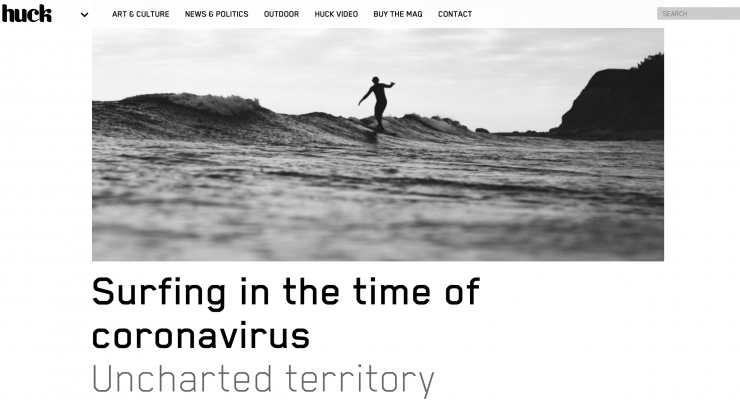
Last week, I stood atop the bluff overlooking Malibu Surfrider Beach. Sets of glassy waves marched in, broke, and peeled across the point with machine-perfect shape. There was not a soul in the water. That never happens. Malibu is one of the most crowded breaks on earth. In my four decades of surfing there, never have I seen the waves that good with no one out.
The sky was a headstrong blue. The sea was shimmering. I watched, transfixed. These were the dream waves straight out of the surf magazines of my teens. We’d pin them on our bedroom walls and draw them on our Pee-Chee folders. The central myth in surfing is the search for the perfect, empty wave. We scour the globe for it. And there it was, right under my nose in this city of 10 million people. The beach was deserted. There was not a single car in the typically bustling parking lot. It was both Edenic and post-apocalyptic. And just as I began to imagine myself sneaking out to grab a few, a police car crept up, as if to say, “Don’t even think about it.”
https://www.huckmag.com/outdoor/surf/surfing-in-the-age-of-the-coronavirus/
Walking the Floor podcast
Malibu Burning - One Year Later
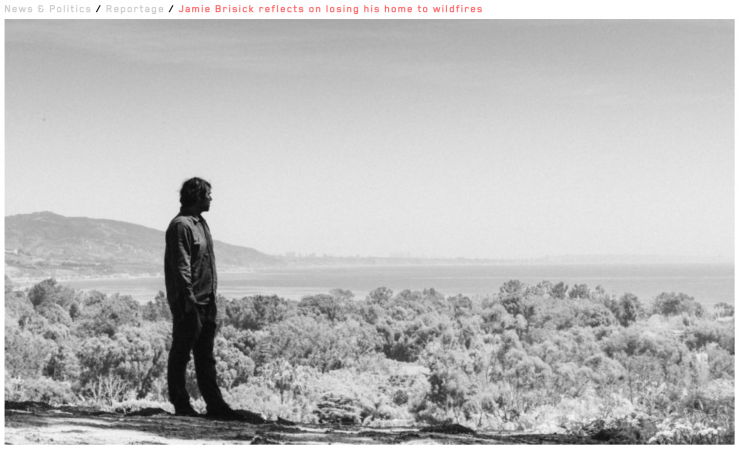
California is on fire. Or at least it is on the homepage of The Guardian, The New York Times, The San Francisco Chronicle, and pretty much every news channel I turn to. There are more than a dozen wildfires burning as I write this. The power shut-offs have affected nearly three-million people in the Golden State, and the power has been shut off in western Malibu, where I have recently moved back to after losing my home last year in the Woolsey Fire.
Surfing in the Age of the Omnipresent Camera
Conversation with William Finnegan
Self Discovery for Social Survival
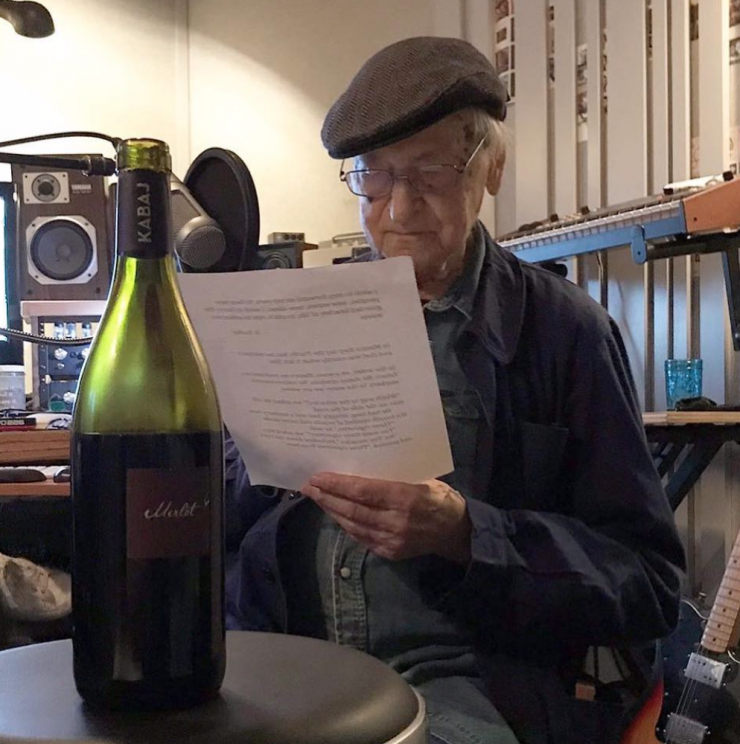
I was an ecstatic cowboy the day that director Chris Gentile asked me to write a VO script for his film-in-progress, Self Discovery for Social Survival. I was even more ecstatic when he told me that Jonas Mekas would do the narration. I was not in the room when Jonas read, but according to Chris he sipped wine and nailed most of the VO on first take.
The film is out. Link below.

